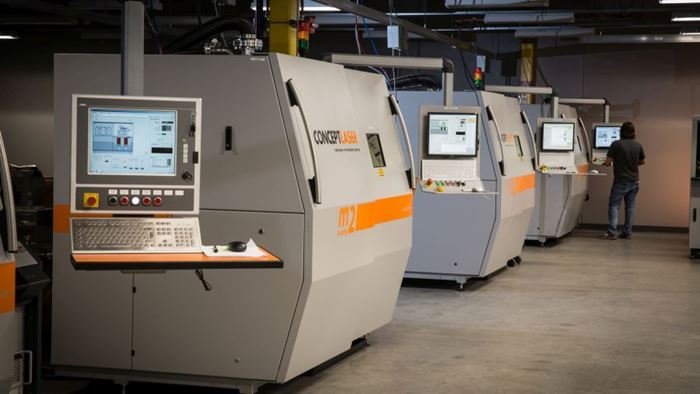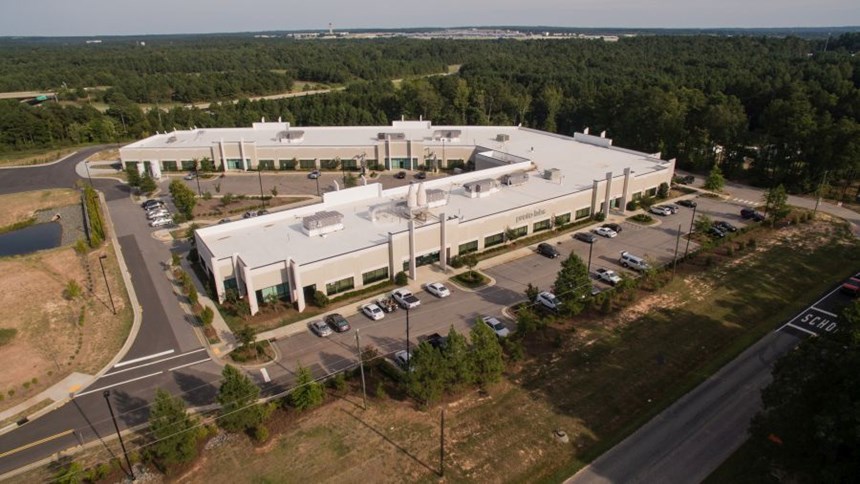Proto Labs Opens New Additive Manufacturing Facility
The new site houses 70 industrial 3D printing machines to provide AM services via e-commerce.
Share
Read Next
Proto Labs recently opened a new 77,000-square-foot additive manufacturing facility in Cary, North Carolina. The company held an open house last week to debut the facility—an appropriate event for a new industrial site. In a way, however, an open house is out of step with the nature of the company’s business and the way this facility will be used. The typical Proto Labs customer will never see the company’s manufacturing resources here and might not even talk to an employee.
“We are a digital manufacturer,” company President and CEO Victoria Holt explained in her presentation to guests. She used the term “e-commerce” as well. As contrasted with other companies providing manufacturing services, fully 100 percent of Proto Labs’ business comes through the online front door enabling customers to upload CAD models and initiate the manufacturing they need. This model has been proven in the company’s CNC machining services, and is now being applied to additive manufacturing as well. (Another type of manufacturing the company also performs in this way is plastics molding.)
While the company’s contract machining work is performed in Minnesota, the additive operation is located in North Carolina because the core of this division came from the company’s 2014 acquisition of 3D printing service provider FineLine Prototyping. (A later acquisition brought AM capacity in Europe as well.) The basic approach to delivering parts within short lead times is similar within each of the separate process areas. That is, on-site staff members perform some manual steps to prepare jobs for production (repairing incomplete models, for example), while software developed by the company automates various steps involved in initiating that production, including scheduling. At the Cary facility, this scheduling includes not only finding open capacity on an appropriate 3D printer for a given job, but also in many cases finding open real estate within a particular build in the same material as that job, so the new part can be nested into a build already scheduled for maximum efficiency.
3D printing analyst and consultant Terry Wohlers spoke at the event, discussing the state of additive manufacturing market growth and recent AM-related developments to an audience that included many who were evaluating using additive manufacturing for the first time. Commenting on the size and organization of the Proto Labs facility and the number of industrial 3D printers here, he said, “I can't name another company worldwide that that has what they have here today.”
The largest share of the site’s 70 additive machines consists of machines making parts through stereolithography, the process with which FineLine began and in which the company specialized. The new site also has 10 selective laser sintering (SLS) machines from 3D Systems for making rugged polymer parts, as well as 13 powder-bed metal additive manufacturing machines from Concept Laser—eight in the small M1 size and five in the larger M2 size. In both the SLS and metal additive manufacturing areas, the available open floor space and utility service leave significant room for additional growth. At one point in her talk, Holt suggested 140 machines was a reasonable expectation for the eventual scale of this site. Already there are plans to add to the number of metal machines.
Related Content
How Norsk Titanium Is Scaling Up AM Production — and Employment — in New York State
New opportunities for part production via the company’s forging-like additive process are coming from the aerospace industry as well as a different sector, the semiconductor industry.
Read MoreHow Machining Makes AM Successful for Innovative 3D Manufacturing
Connections between metal 3D printing and CNC machining serve the Indiana manufacturer in many ways. One connection is customer conversations that resemble a machining job shop. Here is a look at a small company that has advanced quickly to become a thriving additive manufacturing part producer.
Read More3D Printing with Plastic Pellets – What You Need to Know
A few 3D printers today are capable of working directly with resin pellets for feedstock. That brings extreme flexibility in material options, but also requires greater knowledge of how to best process any given resin. Here’s how FGF machine maker JuggerBot 3D addresses both the printing technology and the process know-how.
Read More8 Cool Parts From Formnext 2024: The Cool Parts Show #78
End-use parts found at Formnext this year address various aspects of additive's advance, notably AM winning on cost against established processes.
Read MoreRead Next
Bike Manufacturer Uses Additive Manufacturing to Create Lighter, More Complex, Customized Parts
Titanium bike frame manufacturer Hanglun Technology mixes precision casting with 3D printing to create bikes that offer increased speed and reduced turbulence during long-distance rides, offering a smoother, faster and more efficient cycling experience.
Read MoreAlquist 3D Looks Toward a Carbon-Sequestering Future with 3D Printed Infrastructure
The Colorado startup aims to reduce the carbon footprint of new buildings, homes and city infrastructure with robotic 3D printing and a specialized geopolymer material.
Read MoreProfilometry-Based Indentation Plastometry (PIP) as an Alternative to Standard Tensile Testing
UK-based Plastometrex offers a benchtop testing device utilizing PIP to quickly and easily analyze the yield strength, tensile strength and uniform elongation of samples and even printed parts. The solution is particularly useful for additive manufacturing.
Read More






















